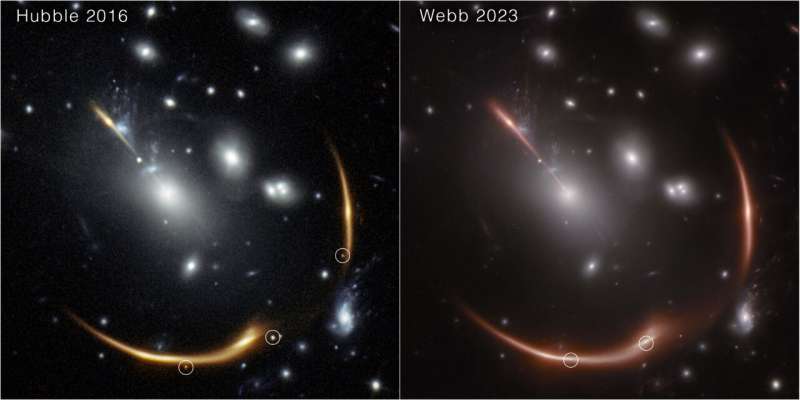In November 2023, the James Webb Space Telescope observed a massive cluster of galaxies named MACS J0138.0-2155. Through an effect called gravitational lensing, first predicted by Albert Einstein, a distant galaxy named MRG-M0138 appears warped by the powerful gravity of the intervening galaxy cluster. In addition to warping and magnifying the distant galaxy, the gravitational lensing effect caused by MACS J0138 produces five different images of MRG-M0138.
In 2019, astronomers announced the surprising find that a stellar explosion, or supernova, had occurred within MRG-M0138, as seen in images from NASA’s Hubble Space Telescope taken in 2016.
When another group of astronomers examined the 2023 Webb images, they were astonished to find that the same galaxy is home to a second supernova seven years later. Justin Pierel (NASA Einstein Fellow at the Space Telescope Science Institute) and Andrew Newman (staff astronomer at the Observatories of the Carnegie Institution for Science) tell us more about the first time that two gravitationally lensed supernovae were found in the same galaxy.
“When a supernova explodes behind a gravitational lens, its light reaches Earth by several different paths. We can compare these paths to several trains that leave a station at the same time, all traveling at the same speed and bound for the same location. Each train takes a different route, and because of the differences in trip length and terrain, the trains do not arrive at their destination at the same time.”
“Similarly, gravitationally lensed supernova images appear to astronomers over days, weeks, or even years. By measuring differences in the times that the supernova images appear, we can measure the history of the expansion rate of the universe, known as the Hubble constant, which is a major challenge in cosmology today. The catch is that these multiply imaged supernovae are extremely rare: fewer than a dozen have been detected until now.”

“Within this small club, the 2016 supernova in MRG-M0138, named Requiem, stood out for several reasons. First, it was 10 billion light-years distant. Second, the supernova was likely the same type (Ia) that is used as a ‘standard candle’ to measure cosmic distances.”
“Third, models predicted that one of the supernova images is so delayed by its path through the extreme gravity of the cluster that it will not appear to us until the mid-2030s. Unfortunately, since Requiem was not discovered until 2019, long after it had faded from view, it was not possible to gather sufficient data to measure the Hubble constant then.”
“Now we have found a second gravitationally lensed supernova within the same galaxy as Requiem, which we call Supernova Encore. Encore was discovered serendipitously, and we are now actively following the ongoing supernova with a time-critical director’s discretionary program.”
“Using these Webb images, we will measure and confirm the Hubble constant based on this multiply-imaged supernova. Encore is confirmed to be a standard candle or type Ia supernova, making Encore and Requiem by far the most distant pair of standard-candle supernova ‘siblings’ ever discovered.””
“Supernovae are normally unpredictable, but in this case, we know when and where to look to see the final appearances of Requiem and Encore. Infrared observations around 2035 will catch their last hurrah and deliver a new and precise measurement of the Hubble constant.”
Provided by
Space Telescope Science Institute
Citation:
Webb spots a second lensed supernova in a distant galaxy (2023, December 21)
retrieved 21 December 2023
from
This document is subject to copyright. Apart from any fair dealing for the purpose of private study or research, no
part may be reproduced without the written permission. The content is provided for information purposes only.